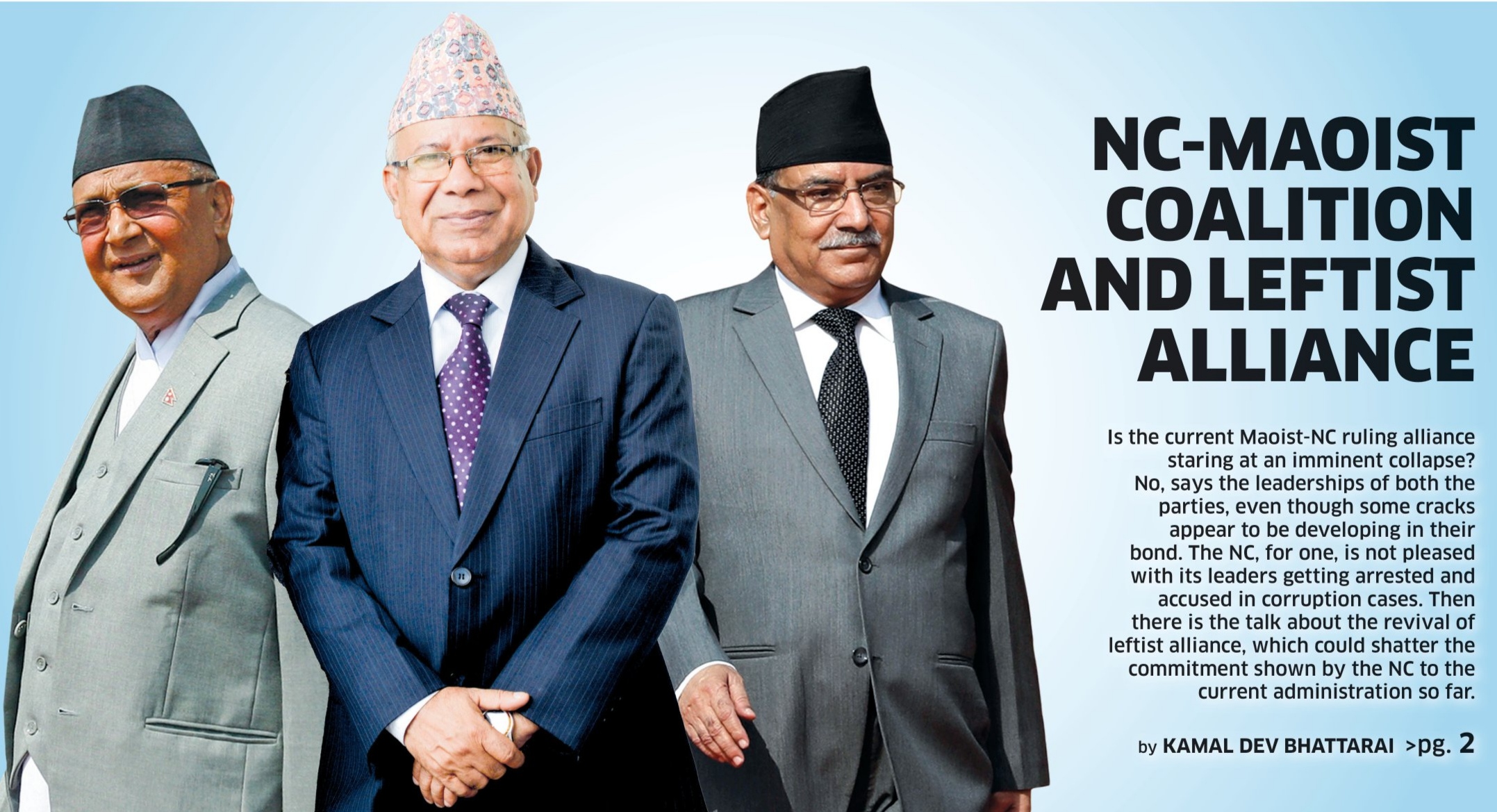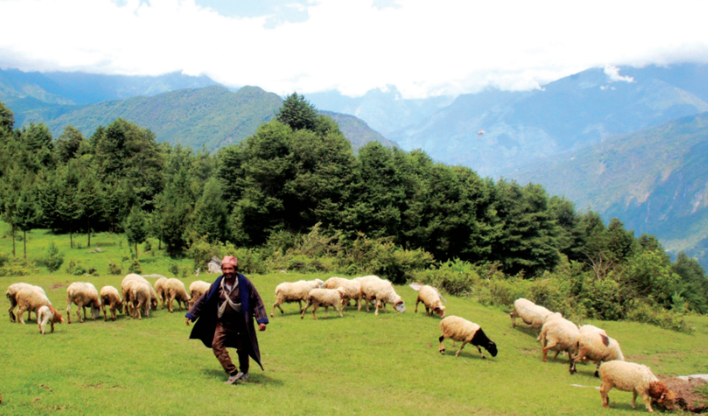Engineer’s Quality Nepal: Enhancing lifestyle
Engineer’s Quality Nepal Pvt Ltd (EQ Nepal) is Nepal’s authorized distributor of household home appliances for Midea. It has been bringing luxury, premium, and high-end products for smaller domestic appliances in the Nepali market since 2020.
“EQ Nepal believes in enhancing lifestyles and offering clients brand-name services at reasonable prices,” says Gyanendra Raj Luitel, president of the company.
Luitel spent more than 20 years living in China, where he gathered knowledge and exposure for starting the business in Nepal. After returning home, he started his business despite the Covid-19 pandemic.
He says many of his friends and relatives advised him against starting a business during the low times of the pandemic, but his thinking was exactly the opposite.
He saw it as a personal challenge with a potential to become a game-changer in Nepali home appliance market.
“I thought it was an opportunity to grow because post-covid the market scenario was going to change,” he says.
EQ Nepal deals in must-have kitchen products, like the cooking hob with a timer system, the first ever in the Nepali market, and the kitchen chimney unit that guarantees better suction power and less noise.
 “We are bringing trending products to the Nepali market,” says Luitel. “And so far, they have been received well by our customers, without any complaints.”
Next, the company is planning to introduce a dishwasher that can be controlled by the so-called ‘internet of things’ (IoT) through the Midea app.
“We plan to be the first company to bring new technologies to Nepal, and we are working really hard towards it,” says Luitel, who believes that brand value is the key to long-term satisfaction and quality of life.
“We are dealing with branded goods that are also affordable,” he adds.
Vinay Kumar Shah, vice-president of EQ Nepal, says the company wants to upgrade the lifestyle of not just one section of Nepali society, but everyone.
“We all deserve a comfortable life and we aim to provide that with quality and range. Midea is for all of us,” he says.
The company believes that when people buy low-quality products from the market, the longevity of the product is not enough. Also, a non-brand product does not have spare parts available in the market if they get broken.
“I agree that branded products come at a bit pricier end, but to look at this in the long term,” says Luitel. “Non-brands have a short life span and they are hard to fix. This will eventually cost you more.”
The company places high trust in Midea products and it is here to prove that to the Nepali customers. So far so good.
“We are bringing trending products to the Nepali market,” says Luitel. “And so far, they have been received well by our customers, without any complaints.”
Next, the company is planning to introduce a dishwasher that can be controlled by the so-called ‘internet of things’ (IoT) through the Midea app.
“We plan to be the first company to bring new technologies to Nepal, and we are working really hard towards it,” says Luitel, who believes that brand value is the key to long-term satisfaction and quality of life.
“We are dealing with branded goods that are also affordable,” he adds.
Vinay Kumar Shah, vice-president of EQ Nepal, says the company wants to upgrade the lifestyle of not just one section of Nepali society, but everyone.
“We all deserve a comfortable life and we aim to provide that with quality and range. Midea is for all of us,” he says.
The company believes that when people buy low-quality products from the market, the longevity of the product is not enough. Also, a non-brand product does not have spare parts available in the market if they get broken.
“I agree that branded products come at a bit pricier end, but to look at this in the long term,” says Luitel. “Non-brands have a short life span and they are hard to fix. This will eventually cost you more.”
The company places high trust in Midea products and it is here to prove that to the Nepali customers. So far so good.
‘Wahala’ book review: Chaotic and confusing
‘Wahala’ by Nikki May caught my eye because the cover looked fun. The blurb and the recommendations at the back also made it sound good. But I should have known better than to judge a book by its cover. It wasn’t a bad book. But it wasn’t very good either. It didn’t leave me with the happy feeling that good books generally do, even if it’s a thriller or a traumatic memoir. In Nigerian culture, Wahala means trouble. Would it be too mean to say the book lives up to its name? But there I’ve said it. With too many POVs, the story feels chaotic and confusing. The characters aren’t fleshed out enough for the readers to truly care for them or their troubles. The issues feel superficial and forced. The premise was promising. I feel May couldn’t do justice to it. Ronke, Boo, and Simi have been friends for over a decade. They are British women of ‘mixed race’—with white English mothers and Nigerian fathers. At university, which is where they met, they bonded over the common identity and the baggage they carry because of it. These ambitious women are like family to one another but they have to work hard to keep it that way with too many issues in their own individual lives. When Isobel, Simi’s childhood friend, enters their lives, the already precarious situation is completely disturbed. Isobel is charming and fun. But she is also manipulative. She is rich and flashy and used to getting her way. The three friends have some secrets, ones they haven’t shared among themselves. But Isobel is sly enough to convince each of them to bare their hearts out to her. Pretty soon, things start to go wrong and there’s trouble brewing for the three women. There’s gossip, scandals, and a lot of destruction. May’s debut novel deals with many issues like race, class, and sexism. But none of these themes are explored enough to really shed light on them. Many readers might be able to identify with one of the four main characters and their messy lives. At times, as the women go about their days, cooking and visiting salons, you feel like you are in the company of friends you have known for a long time. The feeling, however, is fleeting. At best, Wahala is like a soap opera. It will entertain you but it will also have you rolling your eyes, exasperated by all the unnecessary drama. Two and half stars Fiction Wahala Nikki May Published: 2022 Publisher: Custom House Pages: 384, Paperback
Mastering the art of saying no
It’s been an overwhelming week because I took up more commitments than I could handle. And sadly for me, this isn’t the first time it has happened. There have been numerous times in my life when I have simply said yes without thinking, especially in a bid to fit in. The fear of disappointing and upsetting the requester has made me say yes without much deliberation. Most of the time though, this approach has led me down a path filled with regrets. And I’m sure it’s not just me. Many of us must have said yes to uncountable requests we weren’t comfortable with and ended up feeling miserable. There’s a saying “If we don’t prioritize our time, someone else will.” So if people around us are calling the shots for us majority of the time, chances are that we will never be happy with how we spend our days. And if how we spend our days is how we spend our lives, we might be destined to look back at the one life we had with regret. Inspired by the book ‘Essentialism’ by author Greg McKeown, I’ve been taking a long hard look at all the commitments I’ve made and will make in the future. These are a few techniques I’ve learnt from the book as well as from my personal experiences regarding ways to say no. There’s the straight no. You simply say, “No. I’m sorry. I already have a lot on my plate right now. It would be unfair for both of us.” Although this line might sound straightforward and even rude, in most cases, the requester will end up admiring your honesty. Or, if you can’t say no immediately, you could try ‘the pause’. We’ve been operating on autopilot mode ever since our birth and saying yes is one of them. Instead, taking a few seconds to dwell on prior commitments and the toll of the added demand can guide us to an honest answer. With enough practice, you can set the pause as your default response. The calendar check, on the other hand, is when instead of giving a reply right away, we can ask for some more time to check our calendars. If you don’t want to say yes, the best way would be to describe your situation through an email explaining the difficulties surrounding your decision. The usual standard is to do it within a day. However, option one is better if you are just trying to buy time because of the awkwardness of saying no. You can also refer or recommend someone else. Instead of refusing directly, you can suggest someone else to take your place. It’s a win-win situation for everyone involved. ‘I can’t do X but Y is possible’ is also an option. Sometimes you may only be able to say a partial yes. In such cases, it’s okay to offer alternatives and work out a mutually beneficial option for both parties. Then there’s the ‘sure, but’ way of dealing with requests. For those who have difficult bosses or a highly demanding job, there may be too many requests to field from multiple projects. Instead of just saying yes, you can remind our supervisors about how the new demands they have set on you now require a review of priorities and focus. An awareness about my limited time on earth and the consequent regrets of saying yes too often has reminded me of one important equation. It’s something I call the Essentialism 100-10-1: 100 fascinating distractions, 10 worthy pursuits, and 1 true priority. So what will you say no to today? The author is co-founder of My Emotions Matter, an education initiative that helps individuals and teams learn the mindset and skills of Emotional Intelligence. You can learn more at myemotionsmatter.com
Indian developers replace Chinese on some of Nepal’s largest hydro projects
In recent years, Nepal has started to shift hydropower projects worth billions of dollars from Chinese developers to Indian companies. This is happening, experts say, not for economic or ecological reasons—two areas where Nepal’s ambitious pursuit of hydropower has been criticized—but because India, as Nepal’s principal buyer of the exported electricity, apparently refuses to buy power produced by Chinese-built plants. The story of the 750-megawatt West Seti hydropower project in western Nepal shows how geopolitics is steering this shift. In 2012, Nepal signed a memorandum of understanding with the China Three Gorges Corporation to develop the project, one of the largest planned in the country at an estimated cost of $1.2bn. This was followed by a 2017 deal to set up a billion-dollar joint venture company. In 2018, however, the Chinese company backed out, citing lower-than-expected returns, and geographic and other development challenges. According to the Investment Board Nepal (IBN), the government agency responsible for promoting and facilitating domestic and foreign investment in the country, the Chinese company had asked to downsize the project from 750 MW to 600 MW, arguing that the larger amount was not economically viable. “Nepal’s government agreed to the terms and asked for documents to proceed to start the project but the company didn’t submit required documents,” reads a report prepared by IBN for other government agencies. A different reason was given by Sher Bahadur Deuba, the prime minister of Nepal and chair of IBN. “India won’t buy electricity from the West Seti hydro project if it’s built by Chinese companies so I am going to give it to India,” Deuba told the media in May 2022 while campaigning for local elections. The following month, the IBN decided to award the West Seti project to India’s state-owned National Hydro Power Company (NHPC), with an agreement signed in August. In a press release, Deuba said: “We will be able to reduce the trade deficit with India by selling electricity and this will help foster better cooperation and mutual sharing of water resources between two countries.” Another project downriver of West Seti, Seti River-6, was included in this agreement. The total cost of the two projects is now estimated at $2.4bn, although IBN was, when this article was published, yet to upload documents with details about the projects to its website. ‘Geopolitical games’ hamper hydropower development During a ceremony in August to mark the signing of the agreement, NHPC’s president AK Singh said: “It is our history that when we enter a project, we complete it. We understand that West Seti is taken as a harbinger of development. We will not leave any stone unturned.” This is not how this turn of events is perceived by everyone. “There is a strong sense of feeling in Nepal that India promises but doesn’t stand by its promises and we need to deal with it quickly,” said Ranjit Rae, India’s former ambassador to Nepal, during a webinar in August hosted by the Institute of Chinese Studies—a think tank funded by the Indian government. This year, there have been reports of problems with the 900 MW Upper Karnali and Arun III projects being built by Indian companies in Nepal, with deadlines extended and local protests over compensation for relocation. Dipak Gyawali, Nepal’s former minister of water resources, told The Third Pole that the West Seti deal is a loss to Nepal. “Signing an agreement doesn’t ensure project development, as it has been going on for years. It’s not the time to celebrate but to look at how badly the agreement was done as it doesn’t talk about sharing of water resources between two countries,” Gyawali said, explaining that the project will increase the flow of water to India during winter and help irrigate land there, “but there is nothing in return that Nepal is going to receive”. The story of Nepal’s largest planned hydroelectric plant, the 1,200 MW Budhi Gandaki project, is even more complicated. It was supposed to have started generating electricity this year, but construction work has not yet started. In 2017, a few days before leaving office, the cabinet of the Communist Party of Nepal (Maoist Center) and prime minister Pushpa Kamal Dahal decided to award the project to the China Gezhouba Group Corporation, without a bidding process. Later that year, the incoming Nepali Congress party-led government headed by Sher Bahadur Deuba scrapped the contract, citing irregularities and lack of transparency around its award. A court action followed. Then, in February 2018, another government came to power in Nepal, with KP Oli as prime minister heading a coalition of Communist parties. This returned the project to the China Gezhouba Group Corporation in September 2018. In July 2021, Sher Bahadur Deuba returned as prime minister; on 7 April 2022 his government decided to revoke the Chinese company’s license for the Budhi Gandaki project. The decision was made after an announcement in April of a commitment between Nepal and India to expand cooperation in the power and energy sector. “We can clearly see more geopolitical games being played in Nepal’s hydropower in recent years and it will eventually hamper project development,” said Dwarika Nath Dhungel, former secretary of Nepal’s Ministry of Energy, Water Resources and Irrigation. Indian rules exclude Chinese companies from Nepal hydropower As governments changed in Nepal, India altered its rules regarding the purchase of power. In 2016, India introduced an export-import guideline stating that it would buy electricity from companies that are either fully Indian-owned or are at least 51 percent owned by Indian companies. After complaints and lobbying by Nepal, India amended the guideline in 2018 and removed the 51 percent provision, but still there is a caveat. The procedure document reads: “Indian entities may import electricity provided that the generating company is not owned, directly or indirectly by any natural/ legal personality(ies) whose effective control or source of funds or residence of beneficial owner, is situated in/ citizen of a third country with whom India shares land border and that third country does not have a bilateral agreement on power sector cooperation with India.” Though China is not mentioned explicitly, in effect this excludes China. “We have heard from Indian officials that they won’t buy electricity from companies that have Chinese investment. Furthermore, they won’t buy electricity from those companies using Chinese equipment to produce electricity,” said Ganesh Karki, vice-president of the Independent Power Producers’ Association of Nepal (IPPAN). “India buys electricity only from those projects that don’t have Chinese investment, but still it’s better than no trade,” said an official at the Ministry of Energy, Water Resources and Irrigation, speaking on the condition of anonymity. “I don’t see a situation where India can encourage Chinese investment in Nepal’s hydropower as India itself has enough capacity and resources to develop hydro projects in Nepal,” said Rae, India’s former ambassador to Nepal. “It’s evolving though. We had said it was India and Nepal only earlier but now India has been flexible to multilateral investments but not China.” Some experts believe this side-lining of China will harden, especially in hydropower development. “It’s a double standard of India as it has been welcoming investment from [China] to its territory but discouraging [Chinese] investment to its neighbor,” said Anup Kumar Upadhyay, former water resources secretary at Nepal’s Ministry of Energy, Water Resources, and Irrigation. He added: “Fighting on such a large battlefield with such a weak weapon won’t help [India] achieve anything.” Others emphasize that this is not just about investment, but is a strategic matter for India. “China sees Nepal’s water resources through the lens of development and it is a money-making business for them. But for India, it’s a strategic resource and is an issue of security so water is far more important to them,” said former water resources minister Gyawali. He added: “Sadly Nepal doesn’t have its own lens—neither [a] development lens nor a security [lens]. It is lost somewhere and that is an even bigger problem.” Moreover, with development and security the only lenses through which hydropower is looked at, other important issues such as ecological impact or whether projects make economic sense are ignored. Nepal’s electricity-exporting plans These issues have become more important relatively recently, with India only opening its market to Nepal’s electricity in November 2021. According to Nepal’s Ministry of Energy, Water Resources and Irrigation, India had agreed to buy 39 MW produced by two hydropower projects—the 24 MW Trishuli and 15 MW Devighat plants, both developed by India. In June 2022, it increased the amount to 364 MW. Nepal added 710 MW of hydropower to its national grid in 2021, giving the country an energy surplus for the first time and expanding its installed hydropower capacity to 2,190 MW, according to the Nepal Electricity Authority. This is still far from the government’s stated aim of creating 10,000 MW of installed capacity by 2026. The Nepal Electricity Authority hopes to achieve this by 2030, through power purchase agreements for 4,839 MW with private companies and producing 4,341 MW itself. In a June press release, the managing director of the Nepal Electricity Authority, Kul Man Ghising, stated that “the quantity of electricity sold in June and earnings [$13m] made from it suggest trading of electricity with India has been moving forward smoothly”. He also voiced an ambition to transmit electricity through India to its neighbors: “In addition to India, we will sell at least 100 MW electricity to Bangladesh soon and works are in progress. It will happen in the next one year.” Just as long as that electricity does not come from Chinese-built projects, or those using Chinese equipment. The author is the Nepal Editor for the Third Pole, and an environment journalist based in Kathmandu This article was originally published in the Third Pole



















